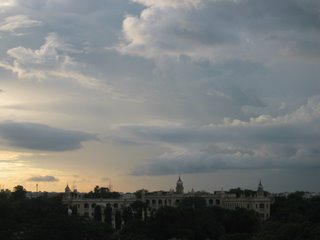Recent posts here have been about such frivolous claptrap that Ludwig cannot countenance any more, pieces on such drivel as reservations, love failure, emerging mobile technologies, entrepreneurship and the death penalty. Pleasurable though it was to conjure up those tidbits, we realize that our vast audience has too long been denied what they were accustomed to in the good old days. Namely, a succinct, comprehensive, well thought out, skilfully constructed, well informed, thoroughly researched, topical article on some burning issue of contemporary relevance. A blob is not just a mere pulpit on the internet from which Thomas, Richard and Sivasubramaniam Chandrasegarampillai can rail at unsuspecting passers-by about whatever catches their fancy. A blog has a greater duty, a higher purpose, a nobler ideal to live up to. It carries forward the great traditions of dissent and critical scrutiny of Zola, Rev. Dr. King Jr., The Onion, &c. It is a public space that oughtn't to be defiled by the washing of dirty linen and the cooking of kaakarakaai pulusu.
To make amends for the last few wasted months, and seeing as it is the zeroeth death anniversary of Saddam Hussein, we have decided to post a little something on history and historiography, two subjects that we have an abiding interest in. Specifically, in this thesis, we will be addressing topics in ancient Indian myth/history, and how 20th century creative sensibilities throw new light on said topics.
To a certain class of people (this author included) with a putative superior engineering education, navel architecture is an engrossing subject, even if we have been landlubbers all our life, and never even caught sight of the blue yonder. For aeons, we have sought perfection in these matters, and have not tasted success in the real world. This essay is not about our failed quest in the real world.
In the halcyon days of our boyhood, we imbibed Indian culture and values through the pores, mainly by the stratagem of gobbling up Amar Chitra Katha comics by the dozen. The long summer afternoons passed as if in a dream, interrupted only by the mysterious appearance of mangoes, gooseberries and so on at Poisson intervals. Those informative volumes introduced us to the wondrous world of Indian history and mythology mostly via memorable illustrations.
The ages passed. Some things that should not have been forgotten were lost. History became legend, legend became myth, and for two score years the comics fell off of all Ludwig's radar screens. Until one day when, in a small hole in Begumpet, Ludwig happened to find himself thumbing through some of those very tomes that had occupied his undivided attentions through those summer months, many years ago.
Things, however, had changed. Having become something of a truth seeker, he was now entranced, in a strictly academic way, by the umm...ah...illustrations of the hemm...haww...midriffs of the err...apsaras and kinnaras and so on. One realized that the Amar Chitra Kathas had had a much more formative effect on one's psyche than one had hitherto suspected.
Being public spirited, one wishes to serve one's people, and keep them informed about all such important matters. So we whipped out our Canon Powershot S45 and proceeded to photograph said volumes, and made notes about the illustrators, which follow.
A quick glance through the entire corpus reveals various levels of clarity and confidence in the depictions of the above mentioned midriffs. Is there something we can learn about the illustrator, from the manner in which he chooses (or does not, as the case may be) to wield his brush when he has to show Anasuya and Priyamvada frolicking amongst the creepers? Can we then, discern an order of merit, in which we can rank these talented artists? And having done so, can we use this order of merit as a guide in future perusals and purchases of the literature?
We will simply present the evidence here, and leave our astute readers to draw their own inferences about the work and the illustrator. And through this creative process which sublimates these external stimuli, into coherent thoughts and locus standi on this seminal issue, we hope (indeed we flatter ourselves), that our faithful readers will learn something of the construction and configuration of their own internal neural pathways and, perhaps, arrive at that pinnacle of Self Understanding, from whence it is very hard to climb down without oxygen cylinders and broken in shoes.
Be that as it may, we move on to the exhibits themselves.
P.B.Kavadi The work on hand is Kalidasa's "Shakuntala". P.B. Kavadi's illustrations are marked by very clean lines; soulful, fish-like, eyes and almost sculptural body types. When we turn to the first page of the "Shakuntala", we are struck by the courage the illustrator displays in depicting the apsara Menaka's considerable charms.

We note the vividity with which the midriff is depicted, and it gives us hope for the future. Alas, it is not to be. Perhaps the artist's courage fails him, after the first flush of valour, and we find subsequently that the midriffs are marked by a marked reluctance to firmly make a statement.


In an effort to determine whether Kavadi's reluctance is a temporary aberration manifested only in the "Shakuntala", we drew samples from "Malavikagnimitra" as well.

And we are disappointed yet again. The artist's style is consistent, it was only the first panel from "Shakuntala" that was the aberration. We move on...
Pratap Mullick Once again, we have a Kalidasa play to base our observations on. "Vikramorvasiyam" is illustrated by Pratap Mullick.

Immediately, we see that indeed, each illustrator has his own style. If Kavadi's is marked by the cleanliness of the lines, Mullick's distinguishing attribute is the classicism he brings to the drawings. The drapiness of robes, the waspiness of waists, the wideness of hips - all well attested to in classical Indian poetic tradition. Once again, we note how the first panel offers hope, in our particular area of interest. Urvashi, we find is exquisite, and we pray that the theme will continue in the inside pages.

Hatha vidhi!! While Kavadi's pictures inside the book at least had a smidgen of ink where a navel should've been, Mullick's Aushinari is devoid of even a blemish. She looks like Damien Thorn's twin sister, very weird.
Ram Waerkar We now move from the realm of pure fiction, to someone who straddles the world of myth and history. We have two samples of Ram Waerkar's illustrations to consider. The first is from "Surya", the story of the sun god.

Waerkar's style seems to be via media between Kavadi's and Mullick's. The clean lines are there, the classicism is conspicuous, and glory of glories, in an internal panel, Waerkar has courageously put an unmistakable dot, where it should be. So much for myth.

Waerkar's style when he draws the story of "Rani Durgavati", is almost wholly different. Gone are the curves and the exaggerations. The pictures have a gritty, almost newsreel feel, the stomping of boots and the clash of musketry is almost palpable. We see that once again Waerkar has not shirked in his duty to art and reality, and wielded his pen or brush with conscientiousness. In summary, it may be said that Waerkar is, while not profligate in his depictions of the midriff, true to anatomy and his oeuvre when he does engage with the subject.
Yusuf Bangalorewalla We conclude with a series of 4 panels from Yusuf Bangalorewalla's "Mirabai". Another historical figure, another recalcitrant artist. The images are breathtaking (we found), and on the spectrum of courageousness, Bangalorewalla lies somewhere between Kavadi and Waerkar.




In conclusion, we find the order of merit to be as follows:
1. Waerkar: For his versatility and courage
2. Bangalorwalla: For the aesthetic, and the nascent ability (that needs to find expression) to be true
3. Kavadi and Mullick. Take a stand, gentlemen. Take a stand, gentlemen, take a stand!
And with these "points to ponder", we at the Choultry wish you all a Happy New Year & c. See you on the other side...
Erratum: The title of this post should read "An Introduction to Ancient Indian Navel Architecture, With Some Observations on Contemporary Popular Historiography". The error is regretted.



















